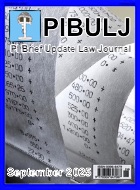News Category 3
PI Practitioner, October 2013

16/10/13. Each issue a particular topic is highlighted, citing some of the useful cases and other materials in that area. You can also receive these for free by registering for our PI Brief Update newsletter. Just select "Free Newsletter" from the menu at the top of this page and fill in your email address.
Accidents at work
The Defence in Ginty v Belmont Building Suppliers Ltd and Boyle v Kodak
Ginty v Belmont Building Suppliers Ltd [1959] 1 All ER 414
The Claimant was replacing asbestos when he fell through a roof. The Defendant employer had instructed the Claimant to...
Image ©iStockphoto.com/EmiliaU
Vicarious Liability: The Times, They Are a-Changing - Thea Wilson, 12 King's Bench Walk

15/10/13. “[Vicarious liability] is not a static concept and has adjusted over the centuries to provide just solutions to the challenges of changing times. And times are still a-changing … We need to adapt to the current demands.” - E v English Province of Our Lady of Charity and another per Ward LJ.
Introduction
Vicarious liability is a long-established doctrine of English law; dating back at least as far as the seventeenth century. The doctrine was “founded in policy rather than conceptualistic reasoning” and essentially creates strict liability of employers for their employees’ acts because for policy reasons it is considered right to impose liability. As with many areas of the common law, the doctrine has always been in a state of evolution, but this has particularly been the case over recent years.
There are essentially two tests to be considered in a case involving vicarious liability. First, whether the relationship between the defendant and the tortfeasor is...
Image ©iStockphoto.com/liveostockimages
Does the Thing Ever Speak for Itself in Medical Claims? - Dr Jock Mackenzie, Anthony Gold Solicitors

14//10/13. Two cases in the last year have again explored the concept of res ipsa loquitur, the Latin maxim literally meaning “the thing speaks for itself”, and its applicability in medical negligence cases. The maxim first appears to have arisen in reported cases in Byrne v Boadle(1863) 9 LT 450, a case in which a barrel of flour from a warehouse hit the plaintiff as he was walking by. Its classic exposition was 4 years later in...
Image ©iStockphoto.com/STEFANOLUNARDI
The Changing Face of a Law Firm - Jeanette Aspinall, Fletchers Solicitors

09/10/13. When the delayed Jackson reforms finally came into effect in April this year, firms across the UK braced for the worst. Six months on, Jeanette Aspinall, head of medical negligence at Fletchers Solicitors, reveals an industry in flux and how the changes have led to innovation.
Earlier this year, redundancies, corporate mergers, even bankruptcy felt imminent for many. Indeed, since the changes to civil litigation were introduced under the Legal Aid, Sentencing and Punishment of Offenders Act 2012, both...
Image ©iStockphoto.com/sodafish
Catastrophic Injury Claims Without Recourse to the Courts - Bill Braithwaite QC, Head of Exchange Chambers

03/10/13. This may sound pathetic, but the best read I've had in a long time is the 2013 Jackson ADR Handbook! In his Foreword, Lord Dyson, Master of the Rolls, says: “…. this book should be as tried and trusted as the White Book and the Green Book.”. I think that ADR may represent a revolution which is about to happen in personal injury litigation; I believe that within five years we will habitually conduct significant personal injury claims without any recourse to the courts.
We've had supposed revolutions before, but they have come to nothing; in my world, the Woolf reforms have probably not added anything of value. This could be different, though. If the climate amongst thinking personal injury lawyers is right, we will all embrace an opportunity which reflects, to some extent, what has been happening...
Image ©iStockphoto.com/webphotographeer












![Appeal judge rules that credit hire company has no costs liability following a finding of fundamental dishonesty in personal injury case: RSA v. Fastrack Solutions Limited [2023] 4 WLUK 92 - David Bowden, Erimus Chambers](/content/images/resized/images/stories/carkeys_72_72.jpg)


